Performance Comparison and Analysis of the Curtain-Wall-Type Liquid-Type Photovoltaic Thermal Unit According to the Pipe Connection Method
Abstract
:1. Introduction
2. Materials and Methods
2.1. CW-PVT Unit
2.2. Fabrication of the CW-PVT and Performance Evaluation of a Single Unit
- : Area of the module;
- : Fluid specific heat (J/kg°C);
- : Solar radiation of slope (W/m2);
- : Inlet fluid temperature (°C);
- : Outlet fluid temperature (°C);
- : Inlet flowrate (kg/h);
- : Maximum current (A);
- : Maximum voltage (V);
- : Thermal efficiency;
- : Electrical efficiency.
2.3. Experimental Conditions and Measurement Equipment
3. Results and Discussion
3.1. Analysis of Experimental Data
3.2. Electrical and Thermal Performance Analysis
3.2.1. Electrical Efficiency
3.2.2. Thermal Efficiency
4. Conclusions
- (1)
- For the parallel-type unit connection, the maximum daily surface temperature was 20.1 °C, and the module was uniformly cooled by the coolant to 16.2 °C on average. For the serial-type unit connection, however, the maximum daily module surface temperature of increased by 15% higher than that of , and that of increased by 12% higher than that of . Thus, the parallel-type method demonstrated a higher module surface cooling efficiency than the serial-type method.
- (2)
- Although the parallel-type and serial-type methods yielded the same electrical efficiency coefficient, the electric loss coefficient of the serial-type method was approximately 62% lower. Furthermore, in comparison to the thermal efficiency coefficient in the serial-type method, which was about 55% higher than that in the parallel-type method, the heat loss coefficient of the serial-type method was −5.6, indicating that heat loss occurred as the insolation correlation coefficient increased. Therefore, the parallel-type connection method yielded both excellent electrical energy generation efficiency and thermal energy generation efficiency according to the insolation correlation coefficient.
- (3)
- Through a field study of the CW-PVT unit, the performances of the parallel-type and serial-type connection methods were derived, compared, and analyzed. The results indicated that the parallel-type method was approximately 10% more efficient for both electrical and thermal energy generation. However, when comparing the coolant temperatures, the serial-type method produced water with a temperature approximately 47% higher than that of the parallel-type method. Consequently, it is advantageous to apply the parallel-type connection method to maximize energy generation efficiency and the serial-type connection method to produce hot water at high temperatures.
Author Contributions
Funding
Institutional Review Board Statement
Informed Consent Statement
Conflicts of Interest
References
- Ministry of Foreign Affairs of KOREA, The Republic of Korea’s Enhanced Update of its First Nationally Determined Contributionits. 2021. Available online: https://www.mofa.go.kr/www/brd/m_4080/view.do?seq=371966 (accessed on 23 December 2019).
- Ministry of Trade, Industry and Energy of KOREA, Industry and Energy (New Renewable Energy Policy Division). New Energy and Renewable Energy Development, Use, and Spread Promotion Law. 2005. Available online: https://www.law.go.kr/lsInfoP.do?lsiSeq=231683#0000 (accessed on 4 December 1987).
- Ministry of Land, Infrastructure and Transport of KOREA, Building Energy Certification Rules. 2017. Available online: https://www.law.go.kr/lsInfoP.do?lsiSeq=191338#0000 (accessed on 20 May 2013).
- Kim, H.; Nam, Y.; Bae, S.; Cho, S. Study on the Performance of Multiple Sources and Multiple Uses Heat Pump System in Three Different Cities. Energies 2020, 13, 5211. [Google Scholar] [CrossRef]
- Park, C.-H.; Ko, Y.-J.; Kim, J.-H.; Hong, H. Greenhouse Gas Reduction Effect of Solar Energy Systems Applicable to High-rise Apartment Housing Structures in South Korea. Energies 2020, 13, 2568. [Google Scholar] [CrossRef]
- Kern, E.C., Jr.; Russell, M.C. Combined Photovoltaic and Thermal Hybrid Collector Systems. In Proceedings of the IEEE Photovoltaic Specialists Conference, Washington, DC, USA, 5–8 June 1978. [Google Scholar]
- Moradi, K.; Ebadian, M.A.; Lin, C.-X. A review of PV/T technologies: Effects of control parameters. Int. J. Heat Mass Transf. 2013, 64, 483–500. [Google Scholar] [CrossRef] [Green Version]
- Abdul-Ganiyu, S.; Quansah, D.A.; Ramde, E.W.; Seidu, R.; Adaramola, M.S. Study effect of flow rate on flat-plate water-based photovoltaic-thermal (PVT) system performance by analytical technique. J. Clean. Prod. 2021, 321, 128985. [Google Scholar]
- Arora, S.; Singh, H.P.; Sahota, L.; Arora, M.K.; Arya, R.; Singh, S.; Jain, A.; Singh, A. Performance and cost analysis of photovoltaic thermal (PVT)-compound parabolic concentrator (CPC) collector integrated solar still using CNT-water based nanofluids. Desalination 2020, 495, 114595. [Google Scholar] [CrossRef]
- Lee, K.-S.; Putrayudha, S.A.; Kang, E.-C.; Lee, E.-J. An Experimental Comparison Study of PVT Water and PVT Air Modules for Heat and Power Co-Generation. J. KJACR 2014, 26, 559–564. [Google Scholar] [CrossRef]
- Kim, J.-H.; Kang, J.-G.; Kim, J.-T. Experimental Performance Comparison of Water Type Glazed and Unglazed PV-Thermal Combined Collectors. J. KIAEBS 2009, 9, 37–42. [Google Scholar]
- Chun, J.-A.; Jeong, S.-O.; Kim, J.-H.; Kim, J.-T.; Cho, I.-S.; Nam, S.-B. A Study on Performance of Flat Water-type PVT Modules According to Absorber Type. In Proceedings of the KSES Annual Autumn Conference, Seoul, Korea, 24 November 2011. [Google Scholar]
- Jeong, S.-O.; Kim, J.-H.; Kim, J.-S.; Park, S.-H.; Kim, J.-T. The Heating Performance Evaluation of Heating System with Building-Integrated Photovoltaic/Thermal Collectors. J. Korean Sol. Energy Soc. 2012, 32, 113–119. [Google Scholar] [CrossRef]
- Kim, Y.-H.; Hwang, J.-H. The Performance Analysis of Curtain Wall-Type Liquid-Type Photovoltaic Thermal Systems through Field Study. J. KIAEBS 2020, 14, 779–790. [Google Scholar]
- Kim, Y.-H.; Hwang, J.-H. The Performance Analysis of Curtain Wall-type Liquid-type Photovoltaic Thermal System Based on Module Arrangement. J. KIAEBS 2021, 15, 350–360. [Google Scholar]
- Bandaru, S.H.; Becerra, V.; Khanna, S.; Radulovic, J.; Hutchinson, D.; Khusainov, R. A Review of Photovoltaic Thermal (PVT) Technology for Residential Applications: Performance Indicators, Progress, and Opportunities. Energies 2021, 14, 3853. [Google Scholar] [CrossRef]
- Kim, Y.-H.; Dai, L.-C.; Nam, Y.-J.; Hwang, J.-H. A proposal for optimal liquid solar and thermal systems (l-pvts) and analysis of seasonal energy production. J. KIAEBS 2019, 13, 55–70. [Google Scholar]
- Dai, L.-C.; Kim, Y.-H.; Yoon, M.-J.; Hwang, J.-H. Economic analysis of solar energy system in factory buildings in national industrial complexes. J. Korean Inst. Archit. Sustain. Environ. Build. Syst. 2019, 13, 609–620. [Google Scholar]
- Kallio, S.; Siroux, M. Energy Analysis and Exergy Optimization of Photovoltaic-Thermal Collector. Energies 2020, 13, 5106. [Google Scholar] [CrossRef]
- Korean Standards Association, KS B ISO 9806, Solar Energy—Solar Thermal Collectors—Test Methods. 2016. Available online: https://e-ks.kr/streamdocs/view/sd;streamdocsId=72059235313975366 (accessed on 28 December 2016).
- ASHRAE 93–77; Methods of Testing to Determine the Thermal Performance of Solar Collectors; American Society of Heating, Refrigerating and Air Conditioning Engineers, Inc.: Corners, GA, USA, 1991. Available online: https://www.osti.gov/biblio/575023 (accessed on 22 November 1985).
- Kim, J.-H.; Chun, J.-A.; Kim, J.-T. The Experimental Performance of an Unglazed PV-Thermal Module with Fully Wetted Absorber. J. KIEAE 2011, 11, 69–73. [Google Scholar]
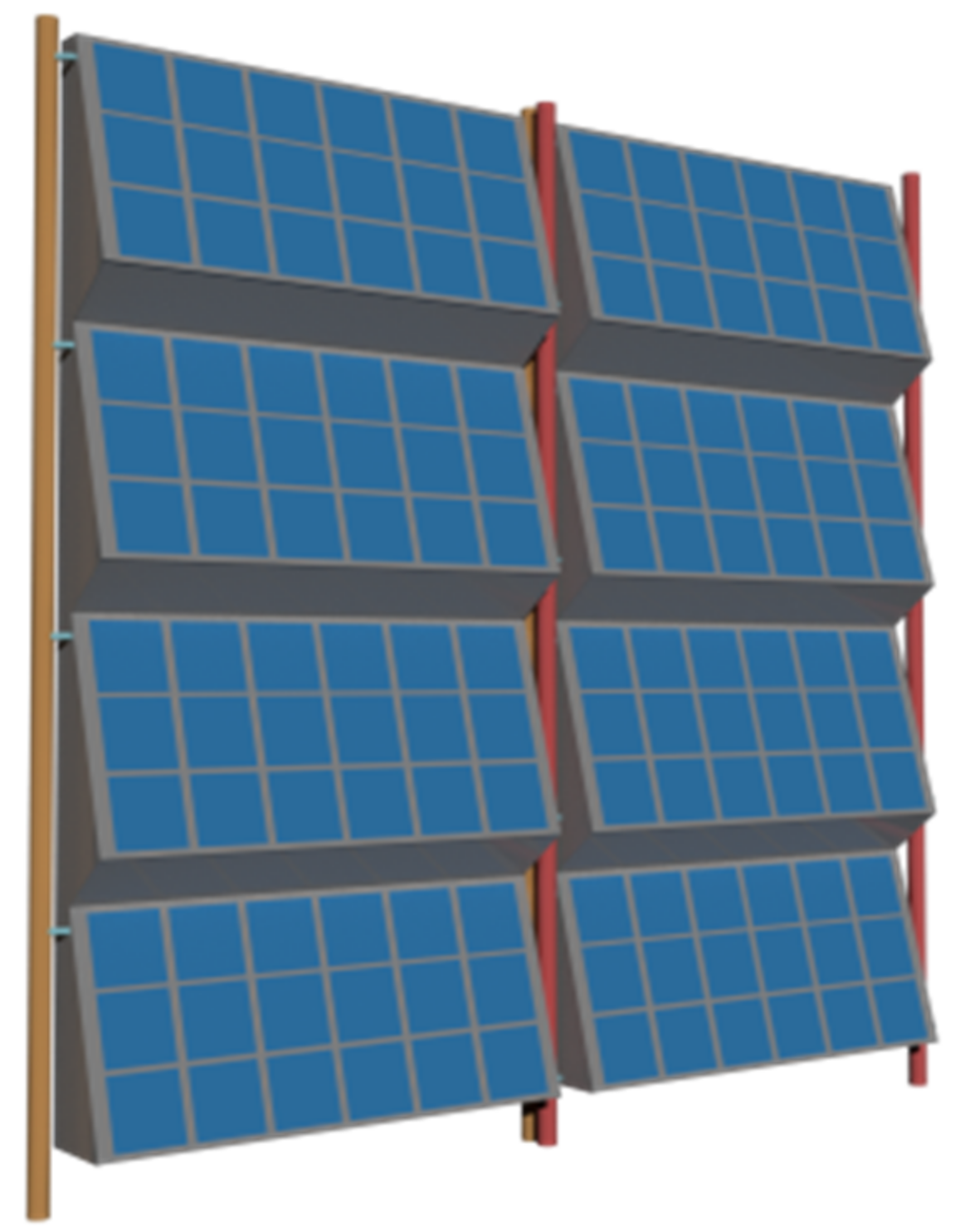
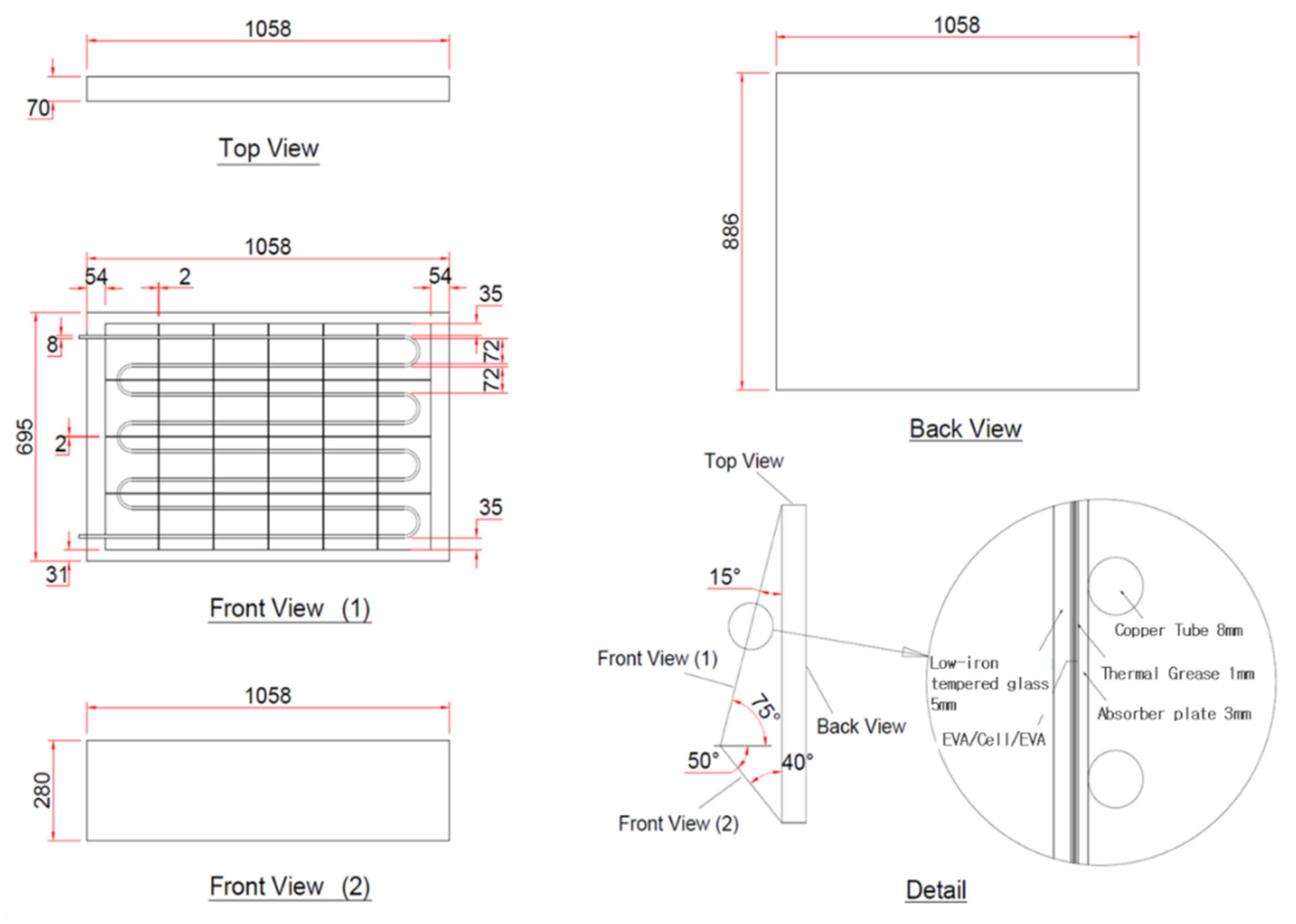
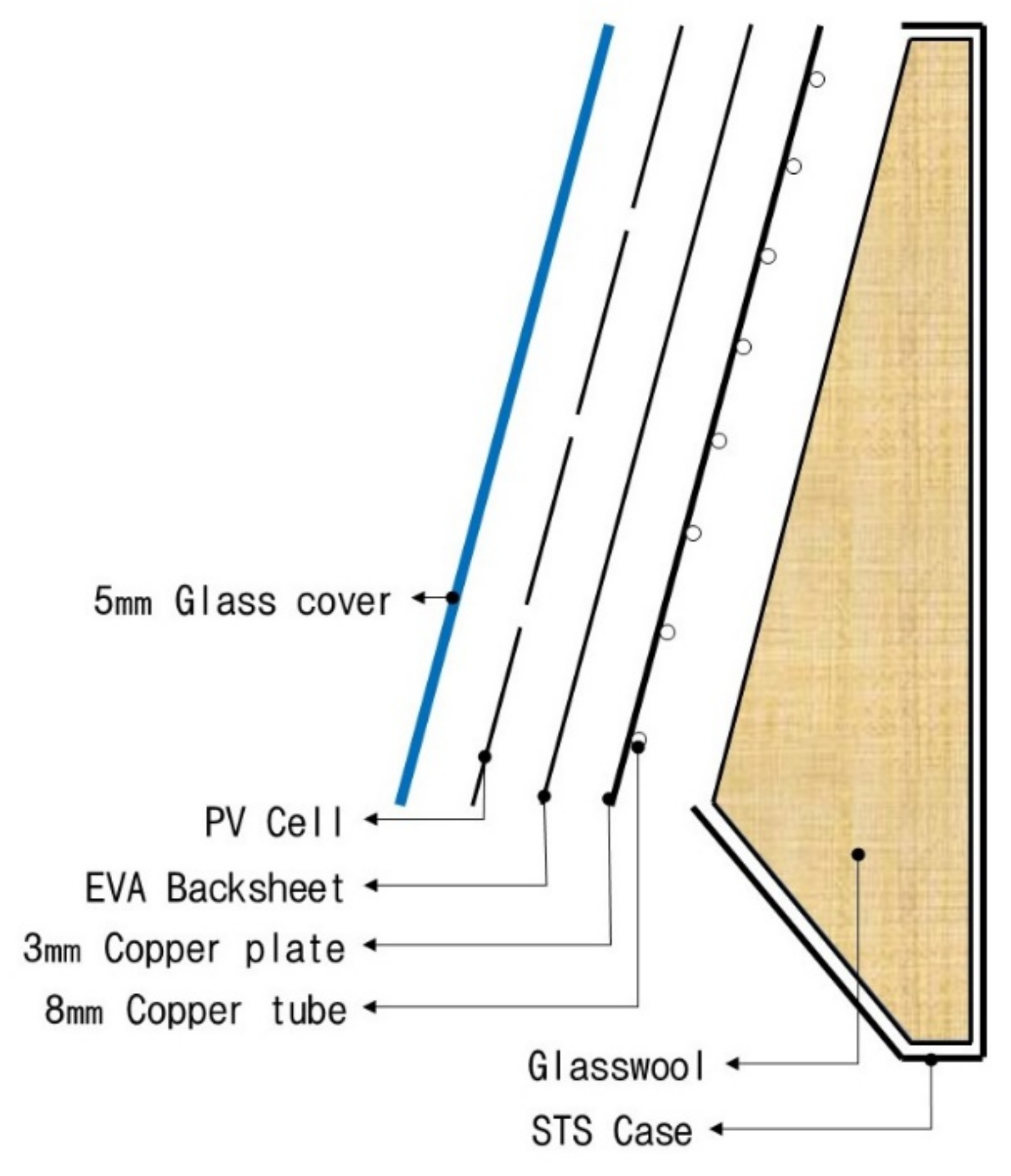
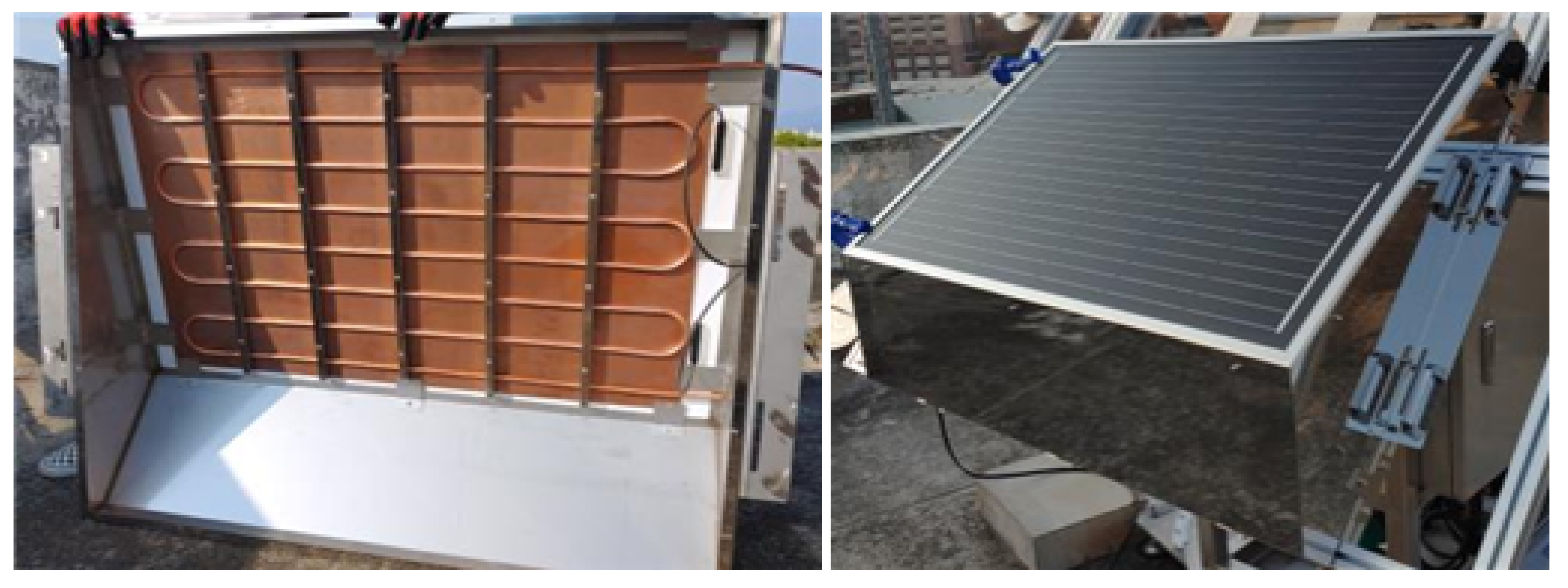




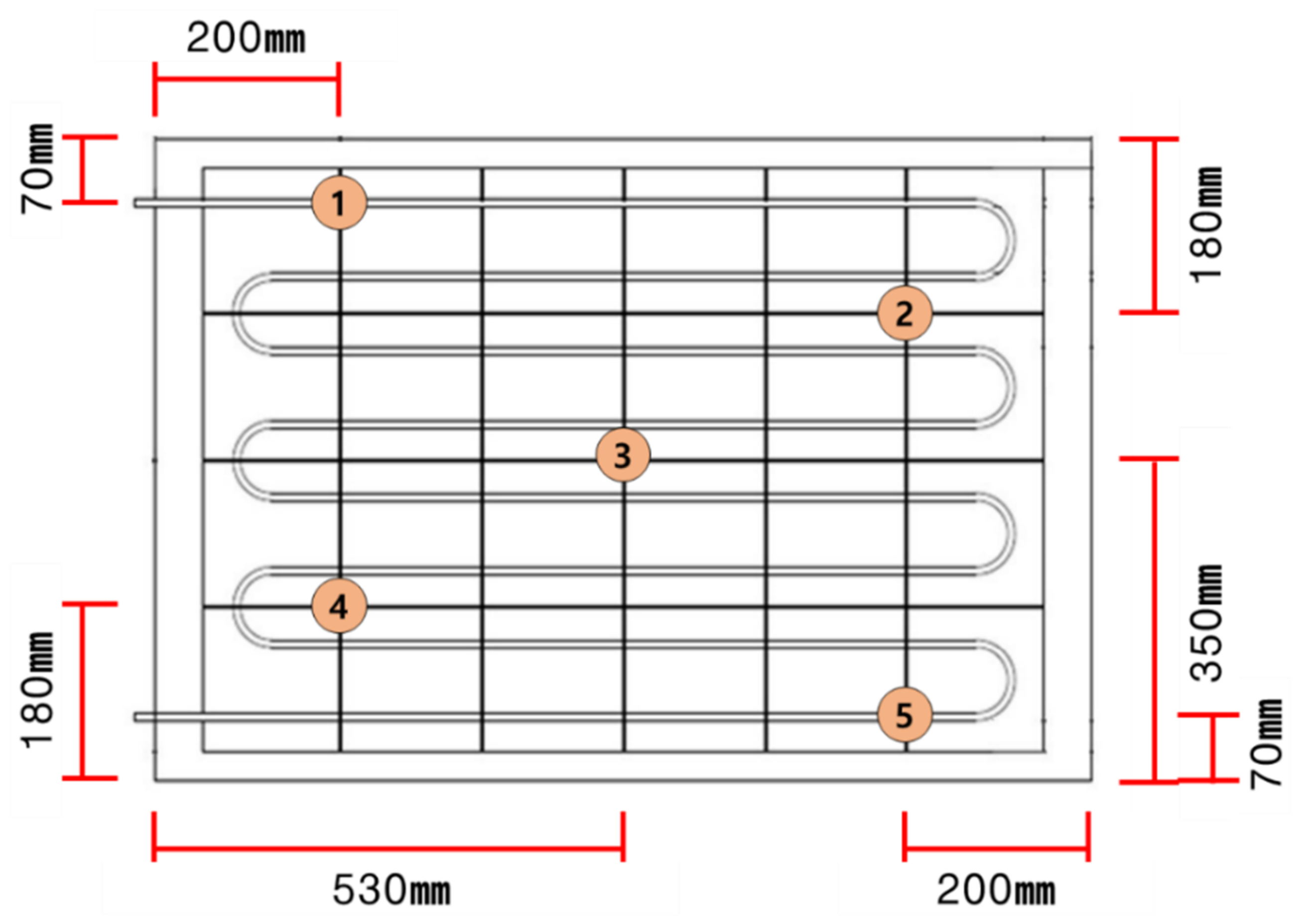

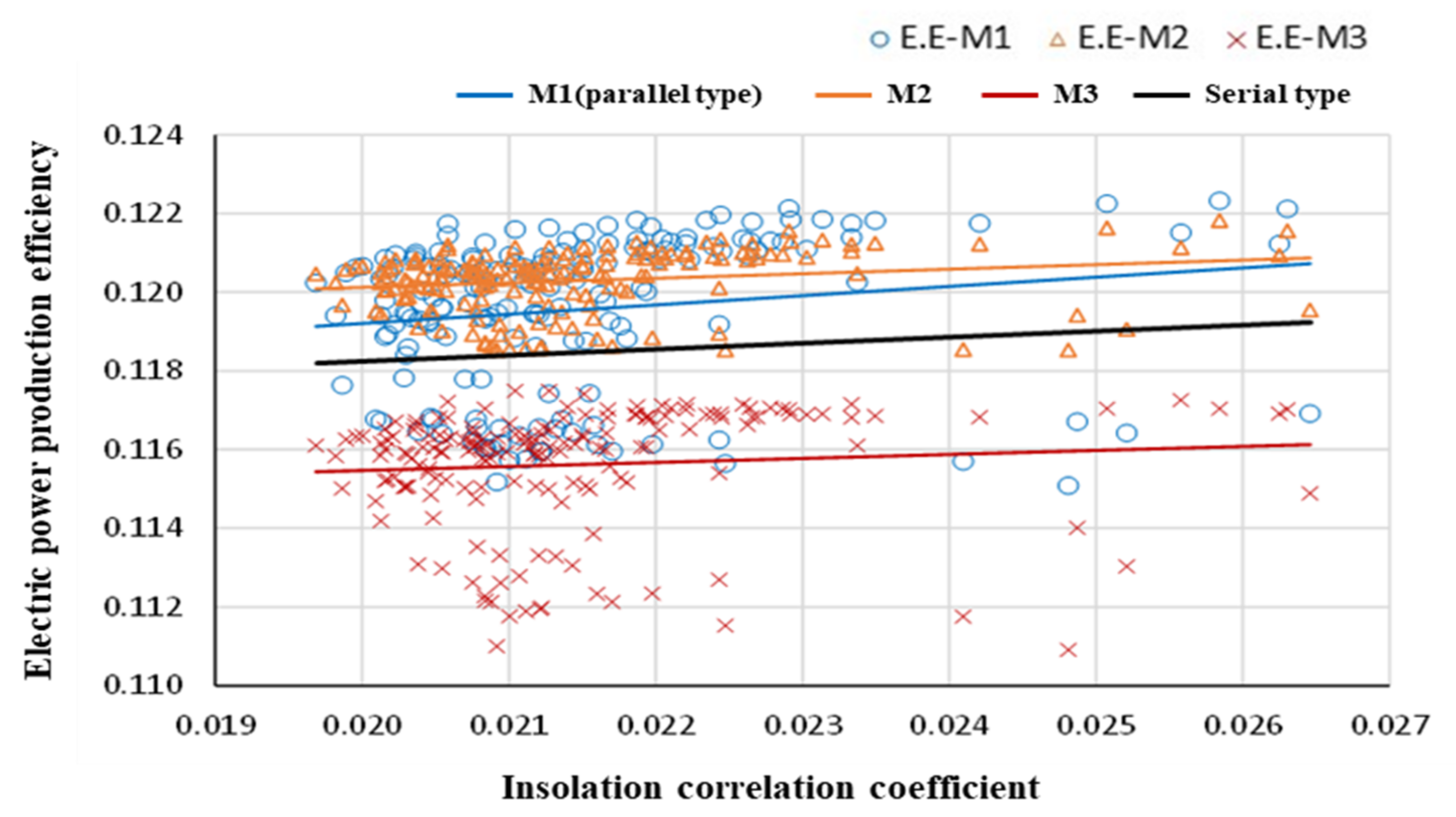

| Description | Value |
|---|---|
| Collector size (mm) | 700 × 1100 |
| Absorber plate thickness (mm) | 3 |
| Thermal conductivity of the absorber (W/mK) | 401 |
| Number of tubes (line) | 8 |
| Tube diameter (mm) | 8 |
| Thermal conductivity of the heat insulating material (W/mK) | 0.05 |
| Thickness of the heat insulating material (m) | 0.3 |
| PV efficiency under the reference condition (%) | 16.4 |
| Module Angle (°) | 15 |
| PV cells per set | 24 |
| Description | Standard | Tolerance |
|---|---|---|
| Wind speed | 1–4 m/s | 1 m/s |
| Solar radiation | 700 W/m2 | 50 W/m2 |
| Inlet flowrate | 0.02 kg/s·m2 | 1% |
| Diagonal angle | ~20° | - |
| Equipment Name | Capacity | Remarks |
|---|---|---|
| Circulating pump | 2.5 LPM | |
| Cooler | 3/4 HP | |
| Electric heater | 3 kW |
| Equipment Name | Model Name | Specification | |
|---|---|---|---|
| Flow meter | MX09P-1TE | Measurement range (flow rate) | 15~500 L/h |
| Precision | ±0.5% | ||
| Repeatability | ±0.03% | ||
| Pyranometer | LPPYRA 02 | Measurement range (insolation) | 0–2000 W/m2 |
| Precision | ±10 W/m2 | ||
| ISO 9060 classification | First class | ||
| Nonstability | 1.5%/years | ||
| Type T thermocouple | TT-T-30-SLE | Operating temperature | −267~260 °C |
| Precision | ±0.5 °C | ||
| Standard limits of error | ±0.75% | ||
| Data logger | DAQ970A | Measurement data | Temperature, voltage, current, resistance |
| Analog output | −10 V–+10 V, 20 mA | ||
| Power meter | WT310E-F | Measurement data | Voltage, current, electricity, resistance |
| Precision | ±0.1% | ||
| Time | 8 | 9 | 10 | 11 | 12 | 13 | 14 | 15 | 16 | 17 | 18 | 19 | Average (%) | Maximum (%) | ||
|---|---|---|---|---|---|---|---|---|---|---|---|---|---|---|---|---|
| Measurement Point | ||||||||||||||||
| = -1 = -2 | 1 | 13.6 | 14.5 | 15.4 | 16.1 | 16.3 | 16.5 | 17.2 | 16.3 | 15.5 | 14.9 | 13.6 | 13.5 | −5.9 | −8.7 | |
| 2 | 13.8 | 14.7 | 15.6 | 16.3 | 16.6 | 16.7 | 17.5 | 16.6 | 15.8 | 15.1 | 13.8 | 13.7 | −4.3 | −6.9 | ||
| 3 | 14.1 | 15.2 | 16.3 | 17.2 | 17.5 | 17.7 | 18.7 | 17.6 | 16.5 | 15.7 | 14.1 | 13.9 | Criteria | |||
| 4 | 14.3 | 15.6 | 17.0 | 18.1 | 18.5 | 18.7 | 19.9 | 18.5 | 17.3 | 16.3 | 14.3 | 14.2 | +3.9 | +6.0 | ||
| 5 | 14.5 | 15.8 | 17.2 | 18.4 | 18.7 | 19.0 | 20.1 | 18.8 | 17.5 | 16.5 | 14.5 | 14.4 | +5.1 | +7.0 | ||
| Average | 14.1 | 15.2 | 16.3 | 17.2 | 17.5 | 17.7 | 18.7 | 17.6 | 16.5 | 15.7 | 14.1 | 13.9 | ||||
| 1 | 14.7 | 16.0 | 17.5 | 18.7 | 19.0 | 19.3 | 20.5 | 19.1 | 17.8 | 16.7 | 14.7 | 14.5 | −4.8 | −6.8 | ||
| 2 | 14.9 | 16.3 | 17.8 | 19.0 | 19.3 | 19.6 | 20.9 | 19.4 | 18.1 | 17.0 | 14.9 | 14.7 | −3.2 | −4.8 | ||
| 3 | 15.1 | 16.7 | 18.4 | 19.8 | 20.2 | 20.5 | 21.9 | 20.2 | 18.7 | 17.4 | 15.1 | 14.9 | Criteria | |||
| 4 | 15.3 | 17.1 | 19.0 | 20.5 | 21.0 | 21.3 | 22.9 | 21.0 | 19.3 | 17.9 | 15.3 | 15.0 | +2.8 | +4.4 | ||
| 5 | 15.5 | 17.3 | 19.2 | 20.8 | 21.3 | 21.6 | 23.2 | 21.3 | 19.6 | 18.2 | 15.5 | 15.3 | +4.2 | +5.6 | ||
| Average | 15.1 | 16.7 | 18.4 | 19.8 | 20.2 | 20.5 | 21.9 | 20.2 | 18.7 | 17.4 | 15.1 | 14.9 | ||||
| 1 | 15.6 | 17.5 | 19.5 | 21.1 | 21.6 | 22.0 | 23.6 | 21.6 | 19.8 | 18.4 | 15.6 | 15.4 | −3.8 | −5.1 | ||
| 2 | 15.9 | 17.7 | 19.8 | 21.4 | 21.9 | 22.3 | 23.9 | 22.0 | 20.1 | 18.7 | 15.9 | 15.6 | −2.3 | −3.8 | ||
| 3 | 16.0 | 18.1 | 20.3 | 22.0 | 22.6 | 23.0 | 24.8 | 22.7 | 20.7 | 19.0 | 16.0 | 15.7 | Criteria | |||
| 4 | 16.2 | 18.4 | 20.8 | 22.7 | 23.2 | 23.7 | 25.7 | 23.3 | 21.2 | 19.4 | 16.1 | 15.9 | +2.2 | +3.5 | ||
| 5 | 16.4 | 18.6 | 21.0 | 23.0 | 23.6 | 24.1 | 26.0 | 23.7 | 21.5 | 19.7 | 16.4 | 16.1 | +3.6 | +4.6 | ||
| Average | 16.0 | 18.1 | 20.3 | 22.0 | 22.6 | 23.0 | 24.8 | 22.7 | 20.7 | 19.0 | 16.0 | 15.7 | ||||
Publisher’s Note: MDPI stays neutral with regard to jurisdictional claims in published maps and institutional affiliations. |
© 2022 by the authors. Licensee MDPI, Basel, Switzerland. This article is an open access article distributed under the terms and conditions of the Creative Commons Attribution (CC BY) license (https://creativecommons.org/licenses/by/4.0/).
Share and Cite
Kim, Y.; Hwang, J.; Bae, S.; Nam, Y. Performance Comparison and Analysis of the Curtain-Wall-Type Liquid-Type Photovoltaic Thermal Unit According to the Pipe Connection Method. Energies 2022, 15, 2317. https://doi.org/10.3390/en15072317
Kim Y, Hwang J, Bae S, Nam Y. Performance Comparison and Analysis of the Curtain-Wall-Type Liquid-Type Photovoltaic Thermal Unit According to the Pipe Connection Method. Energies. 2022; 15(7):2317. https://doi.org/10.3390/en15072317
Chicago/Turabian StyleKim, Yunho, Jungha Hwang, Sangmu Bae, and Yujin Nam. 2022. "Performance Comparison and Analysis of the Curtain-Wall-Type Liquid-Type Photovoltaic Thermal Unit According to the Pipe Connection Method" Energies 15, no. 7: 2317. https://doi.org/10.3390/en15072317







